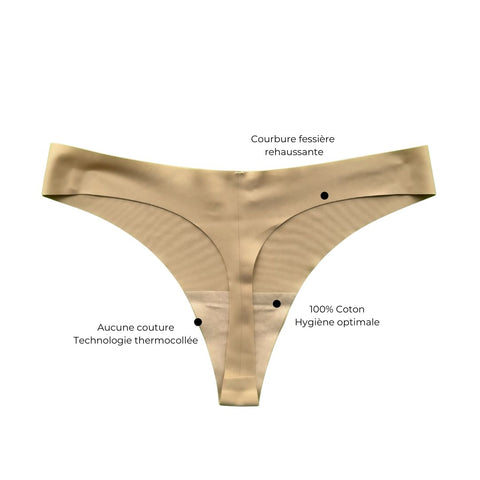How to choose women's underwear that promotes good feminine hygiene?
Underwear is an essential part of a woman's wardrobe, but its impact on intimate hygiene is often underestimated. The choice of underwear can have a significant impact on a woman's health and well-being. Here are some tips for choosing underwear that promotes good feminine hygiene:
Choosing Materials: The Advantages of Cotton and the Disadvantages of Synthetic Materials
Disadvantages of synthetic materials and precautions to take
Breathable materials: Choose underwear made from natural, breathable materials such as cotton. Cotton allows the skin to breathe, reduces moisture buildup, and helps prevent fungal and bacterial infections.
Avoid synthetic materials: Synthetic fabrics like nylon or polyester can trap moisture and promote bacteria growth, which can lead to irritation and infection. If you choose this type of material, make sure there is a cotton lining in the crotch area.

Seamless panties with cotton gusset
Benefits of cotton for better intimate hygiene
Panties with a cotton-lined gusset provide extra protection against wetness and help maintain the natural pH balance of the vagina. Make sure the gusset is also breathable to promote air circulation.
Advantages of cotton:
Breathability: Cotton is a naturally breathable material that allows air to circulate freely through the fabric fibers. This breathability is essential for maintaining a cool and dry intimate area. By allowing air to circulate, cotton helps prevent moisture buildup, reducing the risk of infection-causing bacteria and fungi.
Moisture Absorption: Cotton has the ability to effectively absorb moisture, helping to keep skin dry and comfortable. Cotton's moisture absorption is especially beneficial during periods of increased perspiration, such as during exercise or in hot weather. By keeping the intimate area dry, cotton helps reduce irritation and itching.
Infection prevention: Fungal and bacterial infections, such as candidiasis (yeast infection) or bacterial vaginosis, thrive in warm, moist environments. By choosing cotton underwear, which promotes a dry and ventilated environment, you can help prevent these uncomfortable infections. Additionally, cotton is less likely to cause allergic reactions or skin irritation, making it a safe choice for sensitive skin.
Proper Size: The Importance of a Perfect Fit for Intimate Health
Tips for choosing the right underwear size
Underwear that is too tight can create moisture buildup and unwanted friction and irritation.
Moisture accumulation: Tight underwear tends to trap body moisture, especially in areas where the fabric is in close contact with the skin. This moisture accumulation creates an environment conducive to the growth of bacteria and fungi, which can lead to fungal infections and rashes.
Chafing and irritation: Underwear that is too tight can rub against the skin, causing irritation, rashes, and even abrasions. These irritations can be particularly uncomfortable in the sensitive genital area and can also increase the risk of infections by disrupting the skin's protective barrier.
Tips for choosing the right underwear size:
-
Take accurate measurements: Before purchasing underwear, take accurate measurements of your waist and hips. Use these measurements as a guide to find the underwear size that best fits you.
-
Avoid choosing a size too small: Avoid choosing an underwear size smaller than you need, even if you think it will give you better support. Underwear that is too small can cause more problems than it solves.
-
Opt for comfortable styles: Choose underwear in styles and cuts that provide a comfortable fit without being too tight. High-waisted or elastic waistband panties can be especially comfortable while still providing good support.
Also read: Complete guide to lingerie sizes
Seamless underwear: Comfort and hygiene without compromise

Benefits of seamless underwear for comfort and hygiene
Seamless underwear is an excellent choice because it reduces friction and irritation. Seams can cause irritation, especially if you wear underwear for a long time. Seamless underwear fits perfectly to the body's contours, providing optimal comfort without the risk of irritation caused by seams. This option is particularly recommended for tight-fitting garments where seams could be visible or cause discomfort. By choosing seamless underwear, you minimize the risk of skin irritation and promote better intimate hygiene.
Optimal washing: Best practices for impeccable hygiene
Recommended washing techniques to preserve intimate health
Washing your underwear regularly is essential for maintaining good feminine hygiene and preventing infections. Here are some tips for proper underwear washing:
Washing Frequency: It is recommended to wash your underwear after each use. Wearing dirty underwear for long periods can promote the buildup of bacteria and germs, which can increase the risk of infections.
Use warm water: When washing your underwear, use warm water instead of hot water. Warm water is hot enough to remove dirt and bacteria, but it is less likely to damage the underwear fibers or cause skin irritation.
Use a mild detergent: Choose a mild, hypoallergenic detergent to wash your underwear. Harsh detergents and harsh chemicals can irritate the sensitive skin in the genital area, which can lead to itching, redness, and irritation. Instead, opt for detergents specially formulated for delicate clothing or sensitive skin.
Avoid fabric softeners and perfumed products: Fabric softeners and perfumed products can contain harsh chemicals and irritants that can irritate sensitive genital skin. Avoid using these products when washing your underwear. If you want to add a fresh scent to your underwear, opt for products specially designed for delicate fabrics and sensitive skin.
Proper drying: After washing, air dry your underwear or tumble dry on a low heat setting. Avoid using a high heat setting, as excessive heat can damage the underwear fibers and shorten their lifespan. Also, make sure your underwear is completely dry before storing it to prevent the growth of mold or bacteria.
Also read: The best tips for taking care of your underwear
Frequent Change: The Importance of Daily and Post-Exercise Renewal
Ideal frequency of changing underwear for optimal hygiene
It is recommended to change your underwear daily to maintain good feminine hygiene. Frequent changing helps reduce the buildup of moisture and bacteria in the genital area, which can help prevent infections and skin irritation. Additionally, after exercise, it is especially important to change your underwear to remove sweat and impurities, helping to keep your intimate area fresh and comfortable.
Personal Hygiene: Additional Tips for Optimal Intimate Health
Complementary Personal Hygiene Practices for Maximum Intimate Health
In addition to choosing the right underwear, maintaining good personal hygiene is essential. This includes regularly cleaning the genital area with water and mild soap, and avoiding excessive douching , which disrupts the natural balance of vaginal bacteria.
In conclusion, choosing the right underwear can significantly contribute to maintaining good feminine hygiene. By choosing breathable materials, the right size, and following proper personal hygiene practices, women can reduce the risk of irritation and infection while remaining comfortable and confident in their underwear.
LICA WEAR
A line of seamless underwear that makes you feel like you're wearing nothing.
Stay tuned for our next articles!
Subscribe to our newsletter to be informed of our upcoming blog articles.







